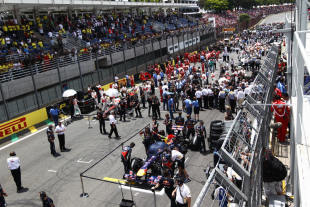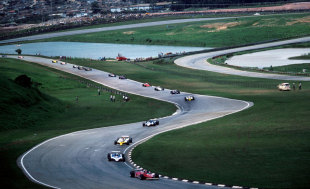
Interlagos is a place of enormous contradictions. By the standard of F1 facilities anywhere else in the world, it falls woefully short. Yet the scruffy paddock hums with an atmosphere driven by the need to make-do. Many times the organisers have promised to put things right but, each year, caterers continue to face a challenge you wouldn't expect to find on a low-rent campsite and journalists dread a typical Sao Paulo deluge for fear of rainwater leaking from the media centre roof.
They say it will be different this year but the likes of Caterham, Marussia and HRT will not be holding their collective breath. It is the lesser teams who must endure life in a cul-de-sac where an already narrow paddock reduces to a scrum and a scuffle as corporate visitors risk being bundled aside by a mechanic in a hurry with a trolley-load of tyres.
Even at the smart end of the paddock, conversations are drowned by engine noise and fumes sweeping over the top of the breeze block partitions separating one team from another. The garages have low ceilings and are seriously cramped.
The team office, such as it is, has to double as meeting room/kitchen/eating quarters/somewhere to sit. The media briefing at Red Bull a couple of years ago had Mark Webber and Sebastian Vettel taking turns to hold group interviews. In Webber's case, he sat at a kitchen table surrounded on all sides by sweating journalists, the fetid atmosphere not helped by the team chef working over a hot stove in one corner as he prepared a spicy meal for the mechanics. Offer this up on a new track today and you would be declared insane. But, at Interlagos, all is forgiven.
For the answer, it is only necessary to take several paces to the back fence. The paddock and main straight are situated on top of a massive escarpment, the track rising from Juncao through that long, long left-hander to meet the start-finish line, only to plunge dramatically downhill through the Senna-S and onto the valley floor once more. From the back of the paddock, you can see most of the track as it twists and turns, rises and falls.

Old hands will tell you it's not like it used to be in the 1970s as the original 4.9-mile track doubled back on itself several times. Look closely and you can see traces of the old cleverly blending in with the new. A nostalgic reminder is served up each day on arrival as the route to the car park moves along a stretch of ancient tarmac where, with very little difficulty, you can imagine Ronnie Peterson opposite locking over the brow towards you in the iconic black and gold Lotus 72.
The contradictions started as you drove past favelas clinging to the hillside overlooking the Pinheiros River and then started your climb towards the circuit and this millionaires' playground in their back yard. Race fans form a noisy but orderly queue up the hill from an early hour, eager to join their fellow countrymen already inside and seated in the sunshine. Arrive at 9am, with the start five hours away, and the overwhelming sound is a samba beat echoing from the grandstands lining the entire length of the back straight on the far side of the valley.
Then the scene switches to the starting grid. There is nowhere quite like it; not even Monaco or Monza can match the sense of occasion that has been building all morning. Monaco has a regal sense of occasion; Monza, a simmering obsession aimed entirely at one team. At Interlagos, you have a carnival mixed with motor racing passion. There is none of the pomposity of Monte Carlo or the menace of Monza. In Brazil, they live for the moment. And they make that moment last all day.
The main grandstand is the closest of any to the start line, the Brazilian grid made even more subservient to the vocal fans by being in a dip directly beneath them. The place simply crackles with tension. I defy anyone to go there and not feel the hairs on the back of their neck stand up. For 15 minutes, once a year, the Interlagos starting grid has to be one of the most thrilling arenas in world sport, never mind motor racing.
Throw in the finale of the world championship and you have a recipe for soaring pulse rates. Interlagos may be a series of contradictions but there is no doubt about its place as a wonderful sporting theatre.
Maurice Hamilton writes for ESPN F1 in the build-up to each Grand Prix.
© ESPN Sports Media Ltd.
 Maurice Hamilton writes for ESPN F1. A veteran journalist in the paddock, Maurice Hamilton has been part of the Formula One scene since 1977 and was the Observer's motor racing correspondent for 20 years. He has written several books as well as commentating on Formula One for BBC Radio 5 Live
Maurice Hamilton writes for ESPN F1. A veteran journalist in the paddock, Maurice Hamilton has been part of the Formula One scene since 1977 and was the Observer's motor racing correspondent for 20 years. He has written several books as well as commentating on Formula One for BBC Radio 5 Live

